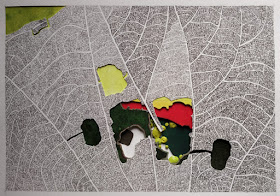About the Exhibition
The
team at TARQ is delighted to present Folly
Measures by Vishwa Shroff. In this exhibition, Shroff continues to journey
through the everyday, focusing on the idea of transience and impermanence. The catalogue is accompanied by an essay
penned by Mumbai based independent curator, writer and researcher, Veeranganakumari
Solanki. The show is both meditative and thought-provoking in the manner in
which Vishwa’s drawings of architectural form uncoversman’s relationship with space
over a period of time.
What
most would overlook or consider mundane, Shroff is able to weave together highlighting
engagement and exclusion through her medium of drawing. The audience is immediately
placed into a curious yet contemplative mood by the detailed window panes, finely
structured partisan walls (playfully named, Partywall)
and speckled cracked floors.
Shroff’s
precision and use of earthly tones is not merely a reflection of fashion
trends, or time periods but access, encroachment and restrictions. Her work
reaffirms that time does not stand still for architecture and the changes
within these architectural structures become indicators of the lives lived
within these spaces.
Solanki
points out in her essay, “at a moment when history’s future is increasingly
uncertain, visual colonial comforts and follies are pulled out in the perception
and adaptation of architecture. Residues and ruins legitimise our current
situation of being, both in the physical and mental state, thereby making us
collective by-products of the past. The patterns and forms seen in the drawings
are from inhabited spaces. We have all perhaps chanced upon spaces such as
these in the city that is dominated by a British architectural identity. The
familiarity of these foreign elements conflictingly embeds itself in a feeling
of normalcy and home. The shared feeling of sentimental colonial amnesia is
acknowledged through habitual mundane elements that visually play out in the
spaces we occupy”.
About the Artist
Vishwa Shroff (b.1980) started her artist training at The
Faculty of Fine Arts, MSU, Baroda in 2002. She continued on to the Birmingham
Institute of Art and Design (UK) in 2003. Her career so far has seen six solo
exhibitions –‘In Residence’ (2018) at Swiss Cottage Gallery, London (UK),
‘Drawn Space’ (2016) curated by Charlie Levine at TARQ, ‘Postulating Premises’
(2015) at TARQ, ‘One Eye! Two Eyes! Three Eyes!’( 2012) at the Acme Project Space, London (UK),
‘Memories of a Known Place’ (2012), Birmingham (UK) and ‘Room: Collaborative
Book Show’ (2011), Vadodara (India). The forthcoming exhibition at TARQ will be
her seventh solo exhibition.
She has taken part in residencies like Swiss Cottage Library,
London, UK (2017); Paradise Air, Matsudo, Japan (2015) and Clarke Griffiths
Levine, Birmingham, UK (2012). Besides
participating in artist residencies all over the world, Shroff has also been a
part of group exhibitions such as ‘Bedroom Spaces’ (2019) at Hospital Club
(UK), ‘ Eating Bread and Honey’ (2018)
at SqW: Lab project space, Mumbai (India), ‘Camden Draw’ (2017) at Swiss
Cottage Library, London (UK), ‘Reading
Room’ (2016) at Saffron Art, New York, ‘Reading Room: Leaves, Threads and
Traces’ (2015), The Winchester Gallery (UK) and ‘Momento Mori’ (2015) at TARQ.
Art gallery in Mumbai, Maharashtra
Address: F35/36 Dhanraj Mahal, C.S.M. Marg, Apollo Bunder, Colaba, Mumbai, Maharashtra 400001
Hours:
Open ⋅ Closes 6:30PM
Phone: 022 6615 0424







